Keywords
|
| Equilateral triangular microstrip antenna, Proximity coupled, Parallel slot, bandwidth, radiation pattern. |
INTRODUCTION
|
| Microstrip patch antennas are widely implemented in many applications in wireless communication due to their attractive features. Therefore they are extremely compatible for embedded antennas in handheld wireless devices. Some of their principal advantages are light weight, low volume, low fabrication cost, easy to mount, low profile, conformal, linear and circular polarization possible, easy to implement by position of feed, dual frequency use possible, solid state devices easily integrated [1]. The patch using a simple proximity coupled feed is advantages due to ease of matching and fabrication [2]. However in equilateral triangular proximity coupled microstrip antenna using a microstrip line feed may often be more appropriate [3] [4] [5]. In general, the impedance bandwidth of the traditional microstrip antenna is only a few percent (2% - 5%) [6]. Therefore, it becomes very important to develop broadband technique to increase the bandwidth of the microstrip antenna for dual band operation [7] [8]. So we designed a parallel slot loaded equilateral triangular proximity coupled Microstrip antenna for dual frequency with enhancing the band width of the proposed antenna. |
ANTENNA DESIGN AND CONSIDERATION
|
| In this paper the proposed antenna has been designed for the frequency of 3 GHz. By loading properly arranged slots in an equilateral-triangular microstrip patch. A low cost glass epoxy substrate material with substrate S1 and S2 having thickness of 0.32 cm with dielectric constant εr = 4.2 is used to simulate the antenna.The Fig. 1 shows the design of parallel slot loaded proximity coupled equilateral triangular microstrip antenna (PSPCETMSA) and Ansoft HFSS antenna module of PSPCETMSA as shown in Fig. 2. |
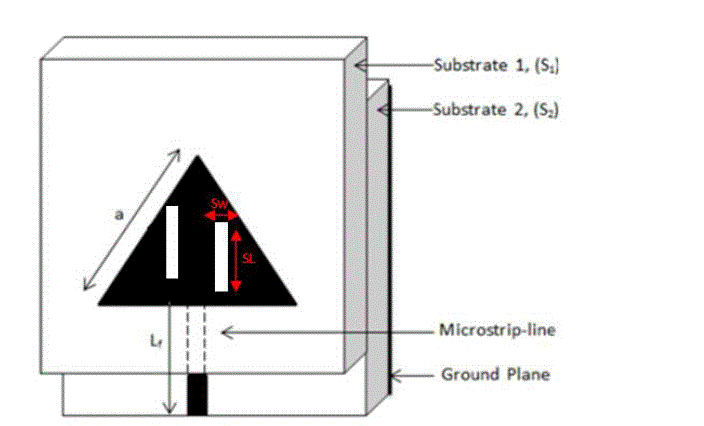
Fig .1 Top view geometry of PSPCETMSA |
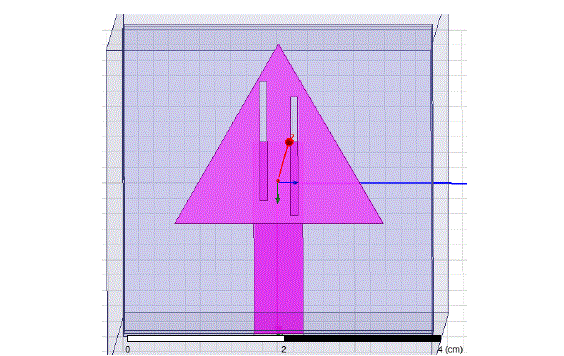
Fig .2 Simulation antenna module of PSPCETMSA |
| The proposed design is achieved by loading parallel slot on the triangular patch by varying the position with same dimensions. The equilateral triangular radiating patch with parallel slot etched on top surface of substrate S1, where SL and SWare the dimensions of the slot respectively. The microstripline feed of Lf and Wf is etched on the top surface of substrate S2. The glass epoxy substrate material S2 is placed below substrate S1 such that the tip of the feed line and the center of the radiating patch consider one over the other. Here the bottom surface of the substrate S2 acts as the ground plane.All the specifications of the proposed antenna are given in Table. 1 |
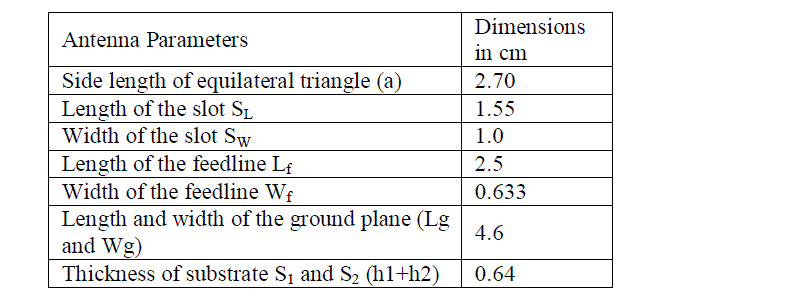 |
SIMULATION RESULTS AND DISCUSSION
|
| The characteristics of proposed antennas have been experimentally designed and measured by using Ansoft HFSS simulation software. The variation of return loss versus frequency characteristics of PSPCETMSA antenna as shown in Fig.3,from this figure it is seen that, the antenna resonates very close to its designed frequency of 3GHz. The impedance bandwidth over return loss less than -10dB it has been calculated by using the equation (1). We also plot the graph for VSWR of the antenna which is shown in Fig. 4. |
 |

Fig.3. Simulation return loss versus frequency of PSPCETMSA |
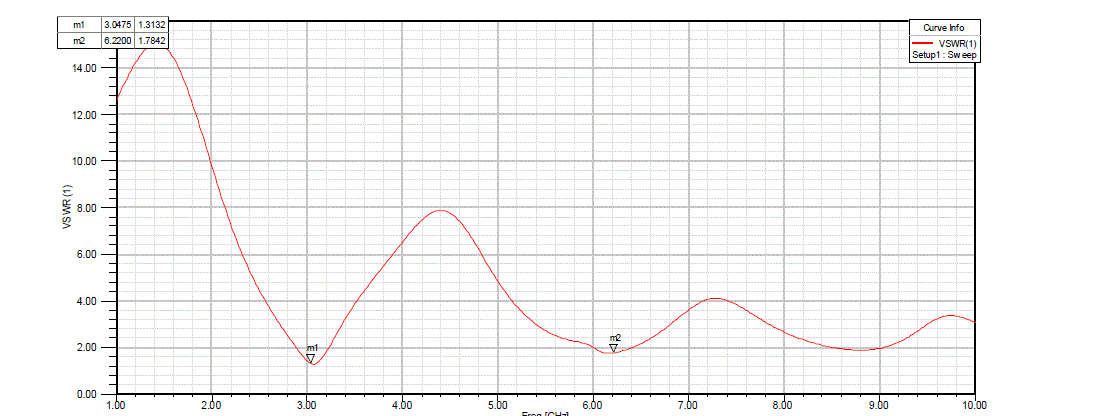
Fig.4. Simulation VSWR of PSPCETMSA |
| From the Fig. 3, it is clear that, the antenna operate between the frequencies 3.07 to 6.22 GHz with impedance bandwidth of 10.49% (2.89GHz-3.21GHz) and 5.37% (6.02GHz-6.35GHz) and the minimum return loss is found to be -17.67dB and -11.00dB, which covers WiMax and Wi-Fi frequency ranges. The measured VSWR of the proposed antenna is 1.31 and 1.78 respectively. |
| The radiation patterns of the simulated antenna at their resonating frequencies are studied and plotted. The E and H plane radiation patterns of the proposed antenna for θ at 00 and 900 and φ at 00 and 900 is as shown in Fig. 5(a) and Fig. 5(b).From these figures it is clear that the obtained radiation patterns are broadside in nature and linearly polarized. |
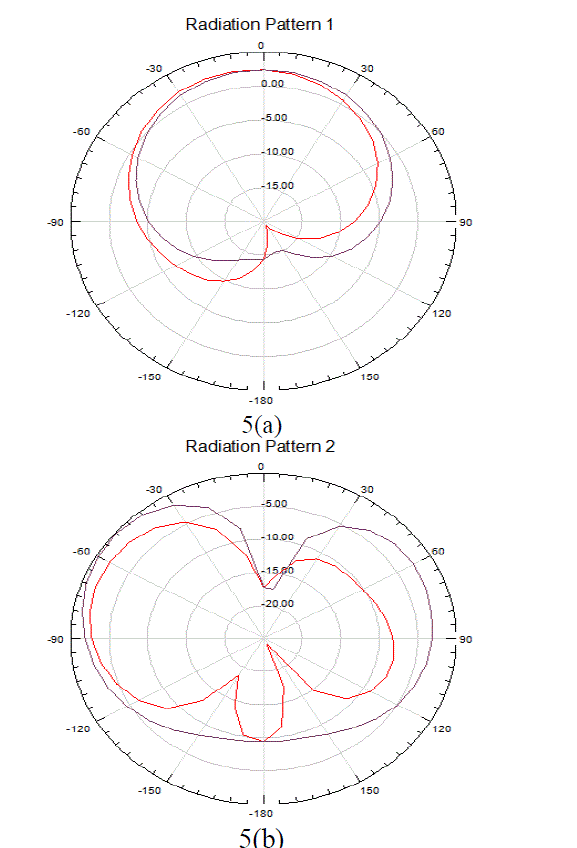
Fig. 5.The simulated radiation patterns of PSPCETMSA measured at 5(a) 3.07 GHz and 5(b) 6.22GHz |
CONCLUSIONS
|
| From the study it is observed that the proposed antenna is simple in their design, compact and they use low cost substrate material. The PSPCETMSA antenna resonates at two different frequency points, also there is enhancement in bandwidth with better broadside radiation characteristics at each resonating frequencies. This antenna can be used for wireless applications such as Mobile Wimax IEEE 802.16 and Fixed Wimax IEEE 802.16. |
References
|
- C. A. Balanis, “Antenna Theory - Analysis and Design”3rd edition, Wiley, 2006
- V. S. Rama Sastry and Dr. K. Jaya Sankar “Proximity Coupled Rectangular Microstrip Antenna X-slot for WLAN Application” Global Journal of Researches inEngineering (F), Vol. 14, Issue. 1, pp. 15-18, 2014.
- GurdeepSingh and Jaget Singh “Comparative Analysis of Microstrip Patch Antenna with Different Feeding Techniques” International Journal of ComputerApplications (IJCA), pp. 18-22, 2012.
- Mahesh C P and P M Hadalgi, “Proximity Coupled Equilateral Triangular Microstrip Antenna with Diamond Shape Slot for Dual Band Operation” InternationalJournal of Advanced Research in Electrical, Electronics and Instrumentation Engineering, Vol. 3, Issue 11,pp. 13115-13119, November 2014.
- Rajesh K Vishwakarma, J A Ansari and M K Meshram “Equilateral Triangular Microstrip Antenna for Circular Polarization Dual-Band Operation” InternationalJournal of Radio and Space Physics, Vol. 35, pp. 293-296, August 2006.
- Sunil Kr Singh and Shirish Kumar Jain “Design of Triangular Microstrip Patch Antenna at Super High Frequency” International Journal of Computer and Informationtechnologies, Vol. 2, Issue.5, pp. 2288-2289, 2011.
- Shubham Gupta and Shilpa Singh “Bandwidth Enhancement in Multilayer Microstrip Proximity Coupled Array” International Journal of Electronics and ComputerScience Engineering, pp. 287-293.
- SwatiTarun Kumar and Amul Kr. Aggarwal “Dual Band Equilateral Triangular Patch Antenna” International Journal of Computational Engineering andManagement(IJCEM), Vol. 15, Issue. 5, pp. 77-79, September 2012.
|